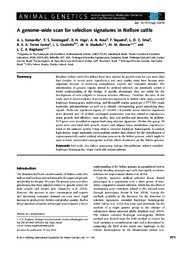A genome-wide scan for selection signatures in Nellore cattle.
A genome-wide scan for selection signatures in Nellore cattle.
Autoria: SOMAVILLA, A. L.; SONSTEGARD, T. S.; HIGA, R. H.; ROSA, A. do N.; SIQUEIRA, F.; SILVA, L. O. C. da; TORRES JUNIOR, R. A. de A.; COUTINHO, L. L.; MUDADU, M. de A.; ALENCAR, M. M. de; REGITANO, L. C. de A.
Resumo: Brazilian Nellore cattle (Bos indicus) have been selected for growth traits for over more than four decades. In recent years, reproductive and meat quality traits have become more important because of increasing consumption, exports and consumer demand. The identification of genome regions altered by artificial selection can potentially permit a better understanding of the biology of specific phenotypes that are useful for the development of tools designed to increase selection efficiency. Therefore, the aims of this study were to detect evidence of recent selection signatures in Nellore cattle using extended haplotype homozygosity methodology and BovineHD marker genotypes (>777 000 single nucleotide polymorphisms) as well as to identify corresponding genes underlying these signals. Thirty-one significant regions (P < 0.0001) of possible recent selection signatures were detected, and 19 of these overlapped quantitative trait loci related to reproductive traits, growth, feed efficiency, meat quality, fatty acid profiles and immunity. In addition, 545 genes were identified in regions harboring selection signatures. Within this group, 58 genes were associated with growth, muscle and adipose tissue metabolism, reproductive traits or the immune system. Using relative extended haplotype homozygosity to analyze high-density single nucleotide polymorphism marker data allowed for the identification of regions potentially under artificial selection pressure in the Nellore genome, which might be used to better understand autozygosity and the effects of selection on the Nellore genome.
Ano de publicação: 2014
Tipo de publicação: Artigo de periódico
Unidade: Embrapa Pecuária Sudeste
Palavras-chave: Beef cattle, Bos Indicus, Desequilíbrio de ligação, Gado de corte, Genotyping, Homozigose do haplótipo estendido, Linkage disequilibrium, Polimorfismo de nucleotídeo único, Relative extended haplotype homozygosity, Single nucleotid, Single nucleotide polymorphism, Single nucleotide polymorphisms
Observações
1 - Por padrão são exibidas publicações dos últimos 20 anos. Para encontrar publicações mais antigas, configure o filtro ano de publicação, colocando o ano a partir do qual você deseja encontrar publicações. O filtro está na coluna da esquerda na busca acima.
2 - Para ler algumas publicações da Embrapa (apenas as que estão em formato ePub), é necessário ter, no celular ou computador, um desses softwares gratuitos. Sistemas Android: Google Play Livros; IOS: iBooks; Windows e Linux: software Calibre.
Acesse outras publicações
Acesse a Base de Dados da Pesquisa Agropecuária (BDPA) para consultar o acervo completo das bibliotecas da Embrapa.

